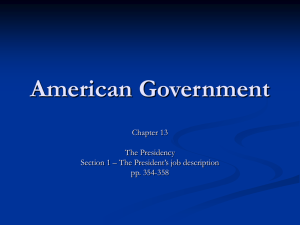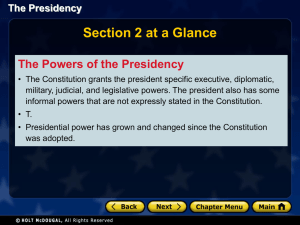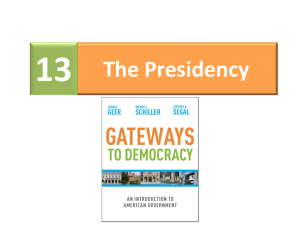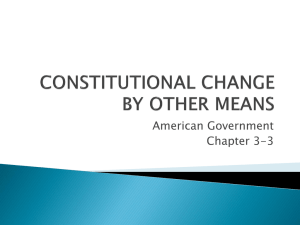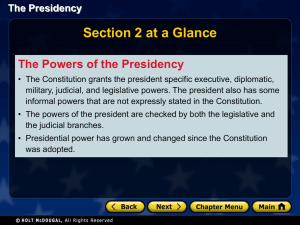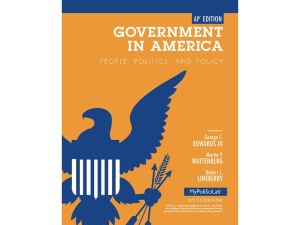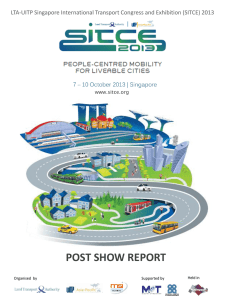President, Congress, Supreme Court
advertisement
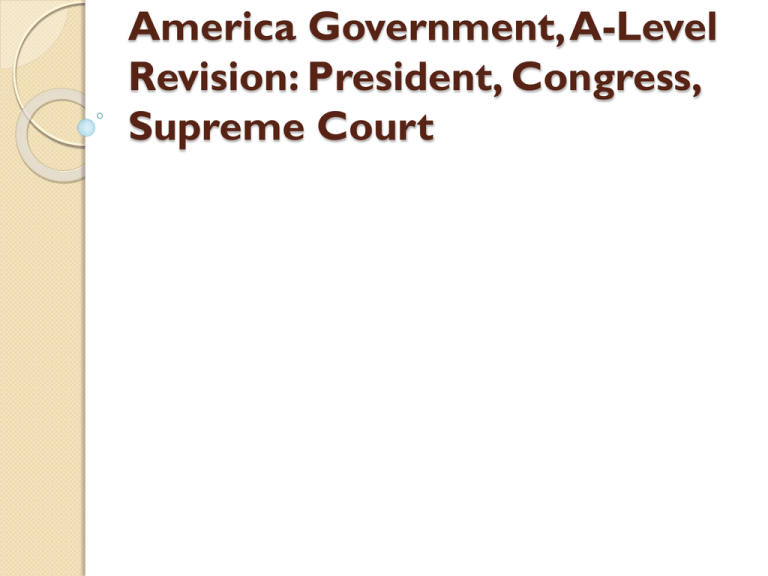
America Government, A-Level Revision: President, Congress, Supreme Court The Presidency Leaving office – 4 scenarios. 1. Loses election 2. Served two terms. 3. Impeachment 4. Incapacity The Presidency – Presidential Power Aaron Wildawsky: Foreign policy: The president dominates and is able to get their way. Domestic policy: The president is checked and hampered by competing institutions. The Presidency – Presidential Power, Foreign Policy Presidential dominance built into the Constitution but: War powers Presidential dominance has increased beyond the constitutional design: Rise to superpower status raises the stakes. Supreme Court legitimates presidential dominance. Congress opts out. The Presidency – Presidential Power, Domestic Policy The Constitution makes the president little more than chief bureaucrat. Today the president has become chief legislator – prepares the budget and brings a programme of legislation to Congress. Presidents can also issue Executive Orders. And they have the veto The Presidency – Presidential Power, Domestic Policy The power to persuade (Neustadt). In order to succeed a president has to persuade other institutions and actors to cooperate because the presidency does not possess the authority to command them to do so. The Presidency – Presidential Power, Domestic Policy Leadership skills (Greenstein): Understanding Congress and knowing how to cut a deal and who with. `Going public’ to win public support to pressure Congress. Prioritization. The Presidency – Presidential Power, Domestic Policy The political environment: Who controls Congress? Public opinion ratings. Honeymoon period or lame-duck? The Presidency – Presidential Power, Domestic Policy An `imperilled presidency’? End of the Cold War. Decentralization of power in Congress. Divided government. Increased partisan polarization. A more hostile media. The Presidency – Presidential Power, Domestic Policy But: The War Powers Act is a dead letter. The `War on Terror’. Divided government has not prevented legislation passing. The president is still in the strongest position to use (manipulate) the media. The Presidency: The Veto When presented with legislation passed by both houses of Congress, the president is constitutionally required to act on it in one of four ways: 1.Sign it into law within 10-days. 2. Issue a regular veto 3. Let the bill become law without his signature. 4. Issue a "pocket" veto. The Presidency: The Veto A powerful weapon – only 0.7% have been overturned. But a negative weapon – can’t be used to enact what the president wants. Veto power is a negotiating tool, an actual veto is a sign of miscalculation. The Presidency: The Veto Veto power is a negotiating tool, an actual veto is a sign of miscalculation. Most vetoes have been of trivial bills rather than major ones. Only 2% of bills have ever been vetoed but rate varies enormously – Gerald Ford vs George W. Bush. Congress: Powers of the House and Senate 435 members elected from districts of equal size. Elected every two years. Intended to be the most powerful branch. Size and diversity means more formal rules than Senate and stronger party leadership. Most important figure is the Speaker – leader of the majority party. He/she controls the legislative agenda and shapes membership of committees. Congress: Powers of the House and Senate 100 members, 2/state. Elected every 6 years (1/3 every 2 years). Represents the states and meant to act as a brake on the popular passions represented in the House. Small numbers mean fewer rules and weaker party structures – a more individualised chamber. One unique rule – the filibuster, can only be halted if 60 senators support a motion of cloture. Congress: The Role of Parties Party Weakness: Separation of powers – `no’ votes do not bring down governments. Members of Congress do not seek promotion to the executive branch. Committee autonomy. Autonomy of legislators during the election process (primaries). Constituency orientation of legislators. Congress: The Role of Parties Party strength: Role and strength of party has grown in past 20 years: Key cause – partisan polarization caused by: 1. Partisan realignment of the South. 2. Resulting changed behaviour of members in Congress. Congress: The Role of Parties Increased partisan unity and polarisation means: Most legislators vote with the rest of their party the large majority of the time. Stronger party leadership. Increased power of the Speaker. Congress displays `conditional party government’. Congress: Voting Behaviour The need to get re-elected. But – different systems = different responses, historically. UK – tow the party line US – meet constituent needs, regardless of party line. Partisan polarization changes this, serving constituents and voting with party are usually the same thing. The Supreme Court The Supreme Court The Supreme Court The Supreme Court The Supreme Court The Supreme Court: Judicial Activism What is judicial activism? Black's Law Dictionary: a "philosophy of judicial decision-making whereby judges allow their personal views about public policy, among other factors, to guide their decisions” Not very useful – describes all justices. The Supreme Court: Judicial Activism What is judicial activism: The opposite of judicial restraint – a Court which chooses to hear politically controversial cases and makes broad, constitutionally significant rulings . The kind of rulings that might be involved are things like overturning existing laws as unconstitutional, overturning precedents and ruling against a generally preferred interpretation of the constitution. The Supreme Court: Judicial Activism Associated with the Warren Court (Brown vs Board of Education, 1954) and therefore with liberalism/modernism. But: Bush vs Gore (2000); Citizens United (2010). The Supreme Court: Cases


